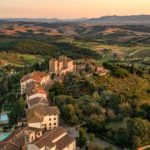Table of Contents
1. Piazza Unità d’Italia- Square of Italian Unity
It is the heart of the city, hence deserves to be the priority destination when you visit Trieste. This breathtaking Piazza is considered the largest sea-facing city square in Europe. The ancient square was much different than today. It was called St. Peter’s Square due to the church built up in 1367. The Church stood for five centuries at the spot where today stands the City Hall “Model”.
The square renamed Piazza Grande. And after its annexation Italy, it became Piazza Unità d’Italia. The square inhibits various culturally and historically significant buildings, which represent the glorious Roman Era through the Mussolini Regime remains to the modern architectural symbols.
2. Miramare Castle
The Archduke Ferdinand Maximilian of Hapsburg builds this Norman Style castle to admire the enchanting beauty of the area when he was seized there by an impetuous bora. The Miramare Castle building is constructed with white blocks of Istrian stone. It was assigned to the Superintendency of Fine Arts and became a national museum in 1955.

Now you can visit the rooms of the castle in which furniture and valuable works collected by the Emperor. You can roam around the lush grounds of the castle with rare species of trees. Here you can see the araucarias of Mexico and the two thirty-meter high redwood trees planted by Archduke himself, the Indian bamboo and arbutus Asia.
3. San Giusto Hill
When you pay a visit to Trieste, you must go to this historical landmark of the city. Forensic basilica remains, located in the square, exhibit its significance since Roman times. You can view, from this dominating point, the gulf, and the urban system below.
Here lies the impressive San Giusto Castle, which was built when Trieste came under the control of Austria. This relaxing site would take your time to explore the surrounded beauty. There is San Giusto Cathedral, a museum, and armory to check out at the place.
4. Teatro Romano
This Roman Era theatre ruins sit right in the middle of the city. The ancient Roman amphitheater is supposed to be built in the middle of the 1st-century CE. This is set a couple of blocks back from the Piazza Unità d’Italia, and at the bottom of the San Giusto Hill.










